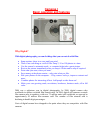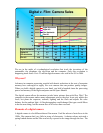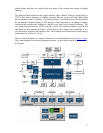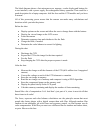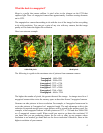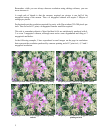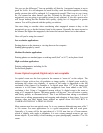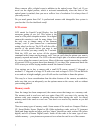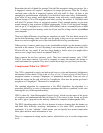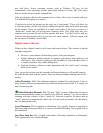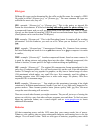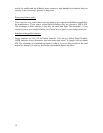8
Remember the rule of thumb for storage? One half the megapixel rating per picture. So a
4 megapixel camera will require 2 megabytes of storage per picture. Thus the 32 mbyte
card that came with the 4 megapixel camera will only hold 16 shots. 16 shots is not
enough for a good afternoon, especially if you decide to shoot some video. Unfortunately,
in an effort to save money most digital cameras come with only a small memory card.
Plan on buying a 128 or 256 megabyte card when you buy the camera. A 256 Mbyte card
will hold 128 pictures from a 4 megapixel camera. That’s enough memory to get most
people through a long weekend of digital photography. If this is still not good enough,
you can get a 512 megabyte or a 1 Gbyte (1000 mbyte) card at a reasonable price to hold
more. A couple good size memory cards are all you need for a long vacation trip without
your computer.
There are slight differences in pricing per megabyte on cards. The best deals seem to be
on the older technology cards, but since you are going to buy one or two cards and reuse
them over and over again the cost of the card should not be a big consideration.
When you buy a camera, make sure you are comfortable with the way the memory card is
accessed in the camera. You will be taking it out occasionally and the newer cards, like
SD and xD, are very small. If you have large hands or tactile issues you might find it
easier to use a larger card, such as a compact Flash (CF).
Some cameras do not have memory cards. They have internal memory only. STAY
AWAY from these cameras. You need a computer to empty the camera; the storage is
small and cannot be expanded. They aren’t worth the savings you get when you buy one.
Compression: What is a “JPEG?”
The CCD is organized in pixels, and each pixel conveys color and luminosity (brightness)
information. It takes about 12 bits (a bit is a 0 or a 1) or 1½ bytes (a byte is 8 bits) Your 4
megapixel camera is storing 6 Megabytes of information internally. From our rule of
thumb the storage on the card will only be 2 megabytes. How does the picture get from 6
megabytes to 2 megabytes? The answer is compression.
The standard algorithm for compression is the JPEG algorithm. An algorithm is a
procedure defined by a series of computer operations that solves a problem, in this case
reducing the size of the required memory.
JPEG is short for “Joint Photographic Experts Group” which was the name of the group
of scientists and mathematicians that developed it. Files stored in this format are given
the suffix .jpg or .jpeg and are the industry standard for compressed photographic files.
The JPEG algorithm reduces the file size because it removes features that the human eye
and brain have difficulty resolving. Information is lost when JPEG compression is
performed. It is also “scalable,” which means you can specify how much compression
takes place and how much information is lost.
There is a compression setting on the camera, which allows you to set the compression
level:



